英语国家概况之澳大利亚共20页
- 格式:ppt
- 大小:2.06 MB
- 文档页数:20
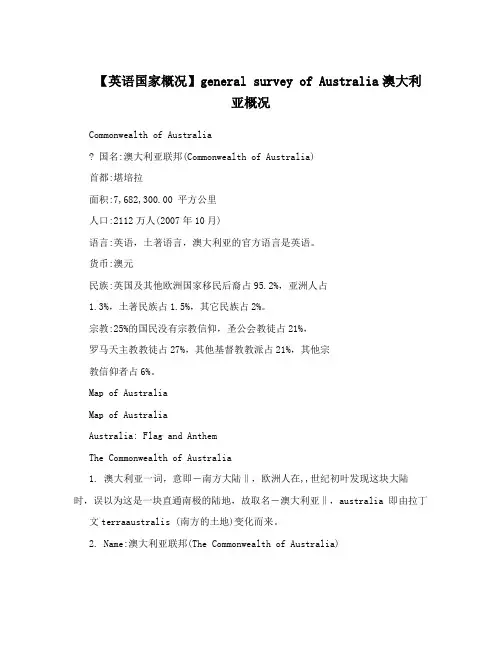
【英语国家概况】general survey of Australia澳大利亚概况Commonwealth of Australia? 国名:澳大利亚联邦(Commonwealth of Australia)首都:堪培拉面积:7,682,300.00 平方公里人口:2112万人(2007年10月)语言:英语,土著语言,澳大利亚的官方语言是英语。
货币:澳元民族:英国及其他欧洲国家移民后裔占95.2%,亚洲人占1.3%,土著民族占1.5%,其它民族占2%。
宗教:25%的国民没有宗教信仰,圣公会教徒占21%,罗马天主教教徒占27%,其他基督教教派占21%,其他宗教信仰者占6%。
Map of AustraliaMap of AustraliaAustralia: Flag and AnthemThe Commonwealth of Australia1. 澳大利亚一词,意即―南方大陆‖,欧洲人在,,世纪初叶发现这块大陆时,误以为这是一块直通南极的陆地,故取名―澳大利亚‖,australia 即由拉丁文terraaustralis (南方的土地)变化而来。
2. Name:澳大利亚联邦(The Commonwealth of Australia)3. National Flag:呈横长方形,长与宽之比为,?,。
旗地为深蓝色,左上方是红、白―米‖字,―米‖字下面为一颗较大的白色七角星。
旗地右边为五颗白色的星,其中一颗小星为五角,其余均为七角。
澳大利亚为英联邦成员国,英国女王为澳大利亚的国家元首。
国旗的左上角为英国国旗图案,表明澳大利亚与英国的传统关系。
一颗最大的七角星象征组成澳大利亚联邦的六个州和联邦区(北部地区和首都直辖区)。
五颗小星代表南十字星座(是南天小星座之一,星座虽小,但明亮的星很多)。
为―南方大陆‖之意,表明该国处于南半球。
4. National Anthem :澳大利亚国徽左边是一袋鼠,右边是一只鸸鹋,这两种动物均为澳大利亚所特有,是国家的标志,民族的象征,中间是一个盾,盾面上有六组图案分别象征这个国家的六个州。
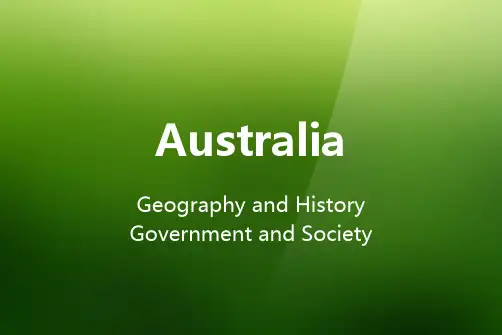
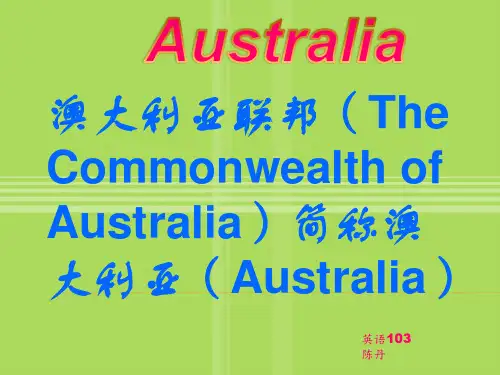

英语国家概况(澳大利亚)Some General FactsNames of the CountryThe Commonwealth of AustraliaDown UnderThe Lucky CountryThe Sunburned CountryOzThe Land of WonderThe Land of PlentyThe Land of the Long WeekendOrigins of the Country’s NicknameExcerpt from “Down Under”On a hippie trail, head full of zombieI met a strange lady, she made me nervousShe took me in and gave me breakfastand she said,“Do you come from a land down under? Where women glow and men plunder?Can't you hear, can't you hear the thunder?You better run, you better take cover."Christian Shephard :Australia is called "Down Under" because it's as close as you can get to Hell without getting burned.Origins of the Country’s NicknameMaking of the CountrySix States◆ New South Wales (Sydney)◆ Queensland (Brisbane)◆ South Australia (Adelaide)◆ Western Australia (Perth)◆ Victoria (Melbourne)◆ Tasmania (Hobart)Two Territories◆ Australian Capital Territory◆ Northern Territory (Darwin)Political Figures of the CountryHead of state: Sovereign(最高统治者)Queen Elizabeth IIGovernor-General: Michael JefferyHead of government: Prime Minister Kevin Michael RuddNational Anthem of the CountryAdvance Australia FairAustralians all let us rejoice,For we are young and free;We’ve golden soil and we alth for toil; Our home is girt(围绕)by sea;Our land abounds in nature’s giftsOf beauty rich and rare;Advance Australia Fair.In joyful strains then let us sing, Advance Australia Fair.Beneath our radiant Southern CrossW e’ll toil with hearts and hands;To make this Commonwealth of ours Renowned of all the lands;For those who’ve come across the seas We’ve boundless plains to share;With courage let us al l combineTo Advance Australia Fair.In joyful strains then let us sing, Advance Australia Fair.National Color of the CountryYellow GreenNational Flora(植物)of the Country Golden Wattle(向日葵)National Flag of the CountryThe Coat of Arms of AustraliaNew South Wales - Golden Lion St George's CrossVictoria - Southern Cross Imperial CrownQueensland - Maltese Cross Imprerial CrownSouth Australia - White-Backed MagpieWestern Australia - Black SwanTasmania(塔斯马尼亚岛)- Red LionCoins and Bank NotesNational Holidays of the CountryAustralia DayAnzac Day C 25 April or, if that day falls Sunday, the following Monday May Day C the first Monday in MayQueen’s Birthday C the second Monday in JunePicnic Day C the first Monday in AugustOther Facts and FiguresPopulation: 20,351,000Capital: Canberra; 373,000Area: 7,692,024 square kilometers (2,969,906 square miles)Language: English, native languagesReligion: Protestant, Roman CatholicCurrency(货币): Australian dollarLife Expectancy(期望): 80GDP per Capita(人数): U.S. $26,900Literacy(读写能力)Percentage: 100Ethnic(人种的)groups:1. White 92%2. Asian 7%3. Aboriginal others 1%Religions:Roman Catholic(天主教)26%, Anglican 21%Christian 21%, Buddhist 2%Islam 2%, others 1%History of the Continent200 million years agoC Australia was attached to Pangaea(大陆).Between 200 and 65 million years agoC Pangaea separated to form Gondwanaland and Laurasia.50 million years agoC Gondwanaland broke up into southern continents with Antarctica and Australia attached.40 million years agoC Australia broke away from Antarctica.Geological Regions of the CountryEastern Highlands◆ The Great Dividing Range◆ The Coastal PlainCentral Lowlands◆ Lake EyreWestern Plateau◆ Large Deserts◆ Ancient RocksThe Dividing Range◆ Stretching along the eastern coast◆ Containing the highest mountain of Australi a CMt. Kosciuszko/Kosiusko (2,228 m)◆ Bordered by sandy(游牧的)beaches and rocky cliffs Lake Eyre◆ Largest lake in the country (9,600 sq km)◆ Lowest point in the continent (12 m)◆ A salt water lake in the arid(干旱的)interiorHistory of the CountryThe First ImmigrantsAborigines C Nomadic Hunters and Gatherers◆ Coming from Asia 50,000 years ago◆ Reaching Tasmania 35,000 years agoHunting and Obtaining Food with Tools and Weapons◆ Core(挖掘)Tools; Grinding(磨的)Stones; BoomerangAboriginal Society◆ Nomadic and kinship band◆ Laws and beliefs upheld(支持)by song, dance and art◆ Without formal system of government◆ Oral tradition and The Dreaming (Dreamtime)How to get a flake from a coreGrinding StoneHatchets Made from Ground-StoneAborigines with BoomerangAboriginal and Modern BoomerangsThe Dutch DiscoveryWillem Janszoon C a Dutch Navigator(航海家)◆ The first recorded European sighting of theAustralian mainland (1606)◆ The first recorded European landfall on theAustralian continentThe Chart of Western and Northern Coast-lines of AustraliaAbel Tasman C a Dutch Explorer◆ The success of sailing into the waters of southern Austra lia (1642) ◆ The discovery of the island Tasmania17th century map of Tasmania, showing the parts discovered by Tasman.The Colonization of AustraliaIn 1768 British Captain James Cook set off to find Australia in the Endeavour .In 1770 King George III claimed possession of the east coast, named New South Wales.On 26 Jan. 1788 the First Fleet arrived in Sydney Cove with 736 convicts. Tasmania became a separate colony in 1825.South Australia in 1836, Victoria in 1851, and Queensland in 1859.South Australia, Victoria and Western Australia were founded as "free province".The Northern Territory(领土)was founded in 1911.The Indigenous(本土的)Australian population declined steeply due to infectious disease.The “Stolen Generations” may have contributed to the decline.The “History Wars”The 1850s Gold RushGold was found in New South Wales and Victoria in 1851.By the 1880s, Australia was a prosperous(繁荣的)country.The final decade of the 19th century was a period of depression.Federal BeginningsThe federation of six colonies formed the Australian nation on 1 January 1901.The “White Australia” Policy was legislated(立法)by the new parliament. ◆ A dictation(命令)test in a European language Three major political groups and two major parties.◆The Protectionists, the Free Traders and the Labor PartyThree major political groups Two major parties.◆ The Protectionists◆ The Free Traders◆ The Labor PartyTwo major parties.◆ The Labor Party◆ The Liberal PartyWorld War IIn 1914, Australia entered WWI to defend Britain.◆ With 64 percent of the 331,781 troops killed or wounded◆ Anzac Day commemorates the landing of the Australian and New Zealand Army Corps at Gallipoli in Turkey on the 25th April 1915. Between the WarsDuring the 1920s, Australia entered a period of major development.◆ Queensland and Northern Territory Aerial Service Ltd. was formed in 1920.◆ Building of the Sydney Harbour Bridge began in 1923.◆ The population reached 6 million in 1925.In 1929 Australia went into economic decline.◆ Wool and wheat prices fell dramatically.◆ By 1931, a third of the country was unemployed.Prices began to increase again by 1933 and manufacturing revived. From 1934 to 1937 the economy improved and unemployment fell. World War IIAustralians again fought in defence of freedom and the “mother land.”In 1942 Darwin, Broome and Townsville were bombed by the Japanese, and two Japanese midget(小型的)submarines entered Sydney Harbour.A major shift in Australian foreign policy away from Britain and towards the USA occurred.In 1951, Australia signed its first defense treaty with a foreign country: the ANZUS treaty.Nearly one million of Australia’s seven million population went to fight. ◆ 34,000 killed and 180,000 woundedPostwar ImmigrationThe postwar immigration programme welcomed not only British immigrants but also Europeans.In 1956, th e status of “permanent resident” allowed non-Europeans to claim citizenship(国籍,公民权).The Menzies Era(时代)From 1949 until 1966, Prime Minister Robert Menzies “reigned”, winning 8 consecutive(连续的)elections.Menzies gave Australians conservatism(保守主义)and stability (坚定). He involved Australians in three more wars, in Korea (1950), Malaya(马来亚)(1955) and Vietnam (1965).Social Unres(动荡)t and ChangesOpposition to conscriptio(征兵)n and the Vietnam War increased in the late 1960s and led to major demonstrations in the capital cities.There was concern for Aboriginal land rights and free education. In 1972, the Labor Party was elected on a platform of social reform.In 1974, an immigration policy without any racial(种族的)discrimination(歧视)was adopted.Return to ConservatismGovernments were more concerned with economic rather than social agendas .Australia emulated most of the Western world with an economic boom(繁荣)in the 1980s, followed by recession(衰退)in the 1990s.By 1986, all legislative(立法机构)ties with Great Britain were broken. The year 2022年saw Sydney host the Summer Olympic Games.Politics of the CountryFeatures of GovernmentA constitutional(宪法的)monarchy(君主政体)◆ The King or Queen of Brita in as the King or Queen of Australia.◆ The Commonwealth of Australia Constitution Act, coming into effect in 1901, consists of 8 chapters.A federation(联邦)◆ 6 colonies and 2 territories federated to form the Commonwealth of Australia.A parliamentary democracy◆ The Parliament of the Commonwealth consists of the King or Queen and 2 houses◆ The Senate (the Upper House) consists of 76 Senators, 12 from each of the 6 states and 2 from each of the territories.◆ The House of Repre sentatives (the Lower House) has 150 members.A parliamentary democracy◆ The Senators are elected by a system of propor-tional representation for a term of 6 years.◆ Members of the Lower House are elected by a system of preferential voting for terms of up to 3 years.◆ 3 important electoral systems in Australia C the simple majority system, the preferential represen-tation system and the proportional (比例)representation system.The simple majority systemIt is a straightforward(明确的)form of voting, by which the option with a simple majority of votes wins.The preferential(优先的)representation systemUnder such a system voters rank candidates in order of preference. The proportional representation systemUnder such a system, the percentage of votes that groups of candidates obtain will determine the percentage of seats they receive.Systems of Government3 levels C a three-tier system◆ The federal government at the national level◆ Governments at the state a nd territory level◆ Locale governments at the city, town, municipal(市政的)and shire (郡)level.3 branches C the separation of powers◆ The legislature(立法机关)C the Parliament(议会)◆ The executive(执行委员会)C the Governor-General / the Federal Executive Council◆ The judiciary C the High Court and other federal courtsPolitical Parties3 major political parties◆ The Labor Party◆ The Liberal Party◆ The National PartyA 2-party system◆ The Labor Party◆ The Coa lition(结合,联合)of Liberal Party and National Party November 2022年, Kevin Rudd from the Labor Party became the 26th Prime Minister of Australia.Economy of the CountryHaving one of the most outstanding(杰出的)economies of the world; With a high-growth, low-inflation, low interest rate;With a flexible labor market and a competitive business sector(部门); Abundant physical resources leading to a high standard of living. Having made a large investment in social infra-structure ;With mining and farming as major industries;◆ coal, copper, gold and iron ore(矿石)◆ sugarcane, grapes and wheat◆ sheep and cattleTourism as one of Australia’s largest and fastest-growing industries.EnvironmentMuch of Australia's flora and fauna(动物群,动物区系) is unique and diverse(多种多样的).◆ About 85% of flowering plants, 84% of mammals, more than 45% of birds, and 89% of in-shore, temperate-zone fish are endemic.◆ Australia has the greatest number of reptiles(爬行动物)of any country, with 755 species.Australian forests often contain a wide variety of eucalyptus(桉树)trees and are mostly located in higher rainfall regions.Among well-known Australian fauna are the monotremes(单孔目动物)(the platypus(鸭嘴兽)and the echidna(针鼹鼠)); a host(群集)of marsupials(有袋动物); the saltwater and fresh-water crocodiles (鳄鱼); and birds such as the emu(鸸鹋)and the kookaburra(笑翠鸟).Environmental concerns over climate changes, enthreatened species, and water restrictions.。
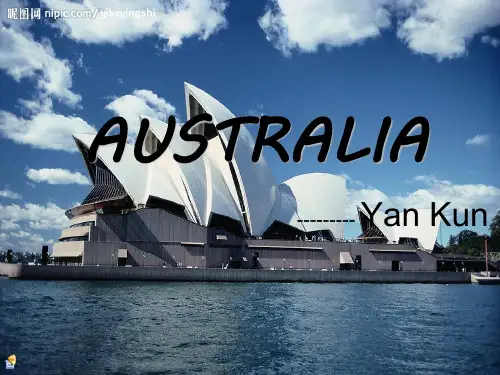
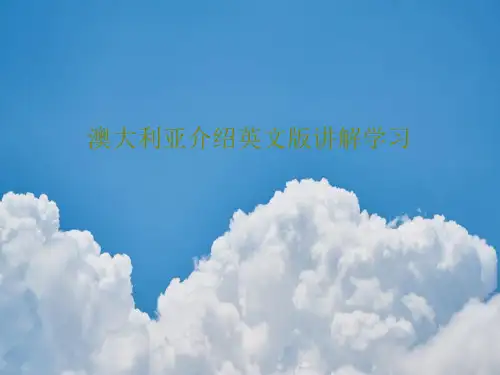
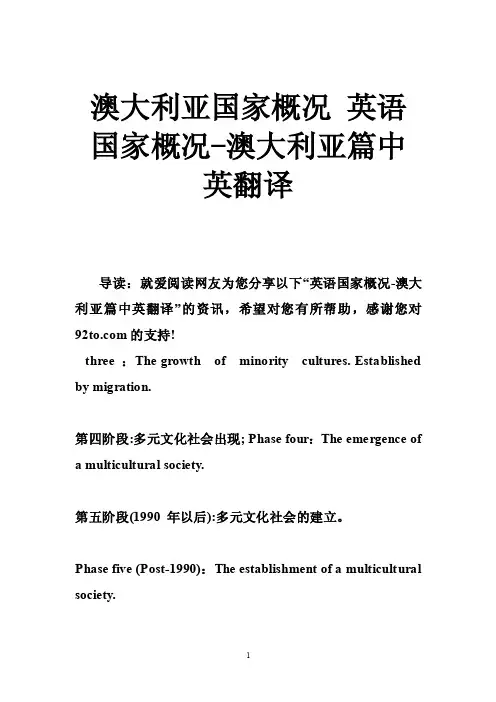
澳大利亚国家概况英语国家概况-澳大利亚篇中英翻译导读:就爱阅读网友为您分享以下“英语国家概况-澳大利亚篇中英翻译”的资讯,希望对您有所帮助,感谢您对的支持!three :The growth of minority cultures. Established by migration.第四阶段:多元文化社会出现; Phase four:The emergence of a multicultural society.第五阶段(1990 年以后):多元文化社会的建立。
Phase five (Post-1990):The establishment of a multicultural society.多元文化社会的建立是由于: multicultural society established by:(1)立法; legislation;(2)代表权; representation;(3)承认土著文化的价值和所有后来移民文化的贡献; recognition of value of original culture and contributions and all subsequent migrating cultures;(4)容忍和接受澳大利亚的文化差异及这种差异与澳大利亚社会的关系;tolerance and acceptance of Australia's cultural diversity and its relationship to Australia's social context.1.土著文化Aboriginal culture他们的历书是分季节的和循环的; 土著人信奉梦幻时代。
这里的大部分的传统文化到20世纪中期都已失去了。
Their calendar was seasonal and cyclical: The Aboriginal people believed in the Dreamtime. the traditional culture had been lost by the mid-twentieth century.2.现代澳大利亚文化Modern Australian culture现代澳大利亚文化是许多传统和多种影响的重叠与混合物:英国的、美国的、欧洲的和亚洲的。
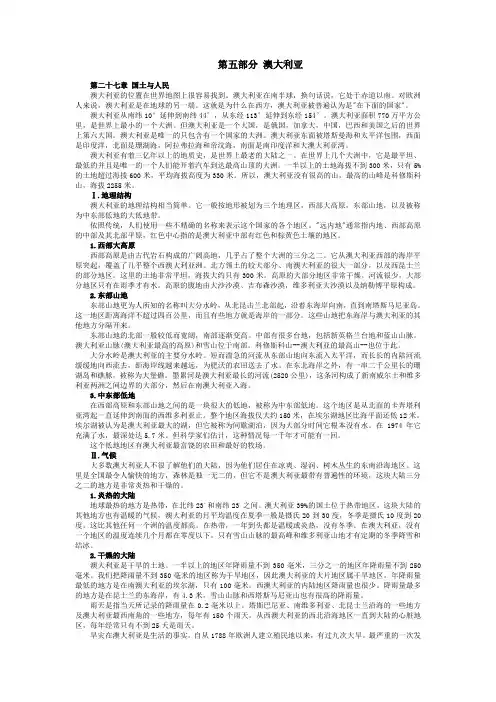
第五部分澳大利亚第二十七章国土与人民澳大利亚的位置在世界地图上很容易找到。
澳大利亚在南半球,换句话说,它处于赤道以南。
对欧洲人来说,澳大利亚是在地球的另一端。
这就是为什么在西方,澳大利亚被普遍认为是"在下面的国家"。
澳大利亚从南纬10°延伸到南纬44°,从东经113°延伸到东经154°。
澳大利亚面积770万平方公里,是世界上最小的一个大洲。
但澳大利亚是一个大国,是俄国,加拿大,中国,巴西和美国之后的世界上第六大国。
澳大利亚是唯一的只包含有一个国家的大洲。
澳大利亚东面被塔斯曼海和太平洋包围,西面是印度洋,北面是珊湖海,阿拉弗拉海和帝汶海,南面是南印度洋和大澳大利亚湾。
澳大利亚有着三亿年以上的地质史,是世界上最老的大陆之一。
在世界上几个大洲中,它是最平坦、最低的并且是唯一的一个人们能开着汽车到达最高山顶的大洲。
一半以上的土地海拔不到300米,只有5%的土地超过海拔600米,平均海拔高度为330米。
所以,澳大利亚没有很高的山,最高的山峰是科修斯科山,海拔2255米。
Ⅰ.地理结构澳大利亚的地理结构相当简单。
它一般按地形被划为三个地理区,西部大高原,东部山地,以及被称为中东部低地的大低地带。
依照传统,人们使用一些不精确的名称来表示这个国家的各个地区。
"远内地"通常指内地、西部高原的中部及其北部平原,红色中心指的是澳大利亚中部有红色和棕黄色土壤的地区。
1.西部大高原西部高原是由古代岩石构成的广阔高地,几乎占了整个大洲的三分之二。
它从澳大利亚西部的海岸平原突起,覆盖了几乎整个西澳大利亚洲、北方领土的较大部分、南澳大利亚的很大一部分,以及西昆士兰的部分地区。
这里的土地非常平坦,海拔大约只有300米。
高原的大部分地区非常干燥。
河流很少,大部分地区只有在雨季才有水。
高原的腹地由大沙沙漠、吉布森沙漠,维多利亚大沙漠以及纳勒博平原构成。
2.东部山地东部山地更为人所知的名称叫大分水岭,从北昆击兰北部起,沿着东海岸向南,直到南塔斯马尼亚岛。

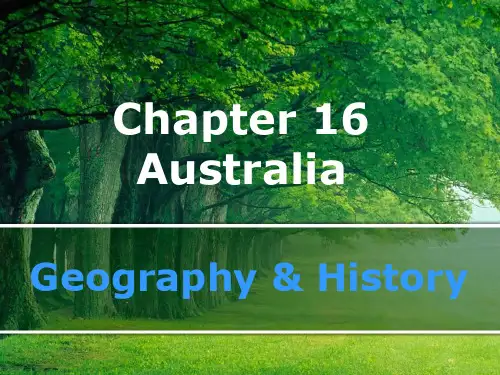
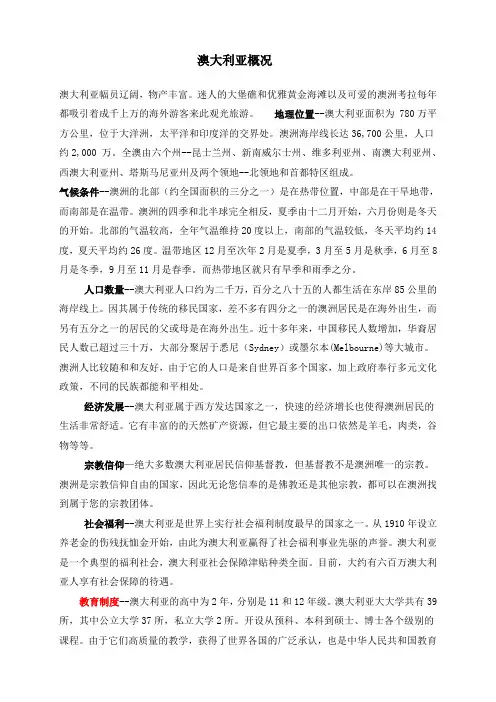
澳大利亚概况澳大利亚幅员辽阔,物产丰富。
迷人的大堡礁和优雅黄金海滩以及可爱的澳洲考拉每年都吸引着成千上万的海外游客来此观光旅游。
地理位置--澳大利亚面积为 780万平方公里,位于大洋洲,太平洋和印度洋的交界处。
澳洲海岸线长达36,700公里,人口约2,000 万。
全澳由六个州--昆士兰州、新南威尔士州、维多利亚州、南澳大利亚州、西澳大利亚州、塔斯马尼亚州及两个领地--北领地和首都特区组成。
气候条件--澳洲的北部(约全国面积的三分之一)是在热带位置,中部是在干旱地带,而南部是在温带。
澳洲的四季和北半球完全相反,夏季由十二月开始,六月份则是冬天的开始。
北部的气温较高,全年气温维持20度以上,南部的气温较低,冬天平均约14度,夏天平均约26度。
温带地区12月至次年2月是夏季,3月至5月是秋季,6月至8月是冬季,9月至11月是春季。
而热带地区就只有旱季和雨季之分。
人口数量--澳大利亚人口约为二千万,百分之八十五的人都生活在东岸85公里的海岸线上。
因其属于传统的移民国家,差不多有四分之一的澳洲居民是在海外出生,而另有五分之一的居民的父或母是在海外出生。
近十多年来,中国移民人数增加,华裔居民人数已超过三十万,大部分聚居于悉尼(Sydney)或墨尔本(Melbourne)等大城市。
澳洲人比较随和和友好,由于它的人口是来自世界百多个国家,加上政府奉行多元文化政策,不同的民族都能和平相处。
经济发展--澳大利亚属于西方发达国家之一,快速的经济增长也使得澳洲居民的生活非常舒适。
它有丰富的的天然矿产资源,但它最主要的出口依然是羊毛,肉类,谷物等等。
宗教信仰—绝大多数澳大利亚居民信仰基督教,但基督教不是澳洲唯一的宗教。
澳洲是宗教信仰自由的国家,因此无论您信奉的是佛教还是其他宗教,都可以在澳洲找到属于您的宗教团体。
社会福利--澳大利亚是世界上实行社会福利制度最早的国家之一。
从1910年设立养老金的伤残抚恤金开始,由此为澳大利亚赢得了社会福利事业先驱的声誉。
Ⅰ.工业 Manufacturing Industry澳大利亚的制造业以制砖开始。
86%的制造业为小企业。
Manufacturing in Australia began with the making of bricks. It is estimated that 86% of all manufacturing firms are small businesses.在世界的总格局中,澳大利亚的制造业是独特的。
它的特点包括下面几点:In a world context Australian manufacturing is unique. Its features include the following:1)效率低Inefficiency澳大利亚的市场有限,它在地理上与外界的隔绝以及很高的关税壁垒是影响澳大利亚工业效率的几个因素。
Australia's limited local market, its geographical isolation and high levels of tariff protection are the factors that affect the efficiency of Australian manufacturing.效率最低并且最受保护的工业是汽车、纺织、服装和制鞋工业。
The industries that are most inefficient and most highly protected are automobile, textiles, clothing and footwear industries.2)高度集中Concentration在过去20年里,大的联合企业在澳大利亚经济中一直起中心作用。
Over the last 20 years large conglomerates have been given a central role in the Australian economy.整个钢铁工业由一个公司控制,这就是布洛肯·希尔专卖有限公司。
The Commonwealth of AustraliaSymbolsFlag∙Composed of the Union flag (loyalty to the British Empire)∙The Commonwealth Star (Represents the 6 states and territories)∙The Southern Cross (a star constellation in the southern hemisphere)National Anthem∙“Advance Australia Fair”The Land and the PeopleThere are 6 states and territoriesThe capital is CanberraThree physical regions∙Western Plateauo Covers 60% of Australiao Interior and center are referred to as The Outbacko The Australian deserts are known as “The Heartless Center of Australia”▪Great Victoria – the largest desert in Australia▪Great Sandy – the second largest desert▪Tanami – the third largest desert▪Simpson – the fourth largest desert▪The Gibson – the third largest desert∙Ayres Rock / Uluru – the world’s largest rocko Nullarbor –means “no trees”▪Most famous and frequently traveled desert▪Nullarbor Plain is the world’s largest piece of limestone▪Eyre Highway goes through it, the longest straight road in the world▪Has the world’s longest cliff face▪Indian Pacific in the longest stretch of straight railway track ∙Central Lowlandso Also known as the Great Artesian Basino Lowest point in Australia is Lake Eyre, the largest artesian basin in the worldo Contains five major deserts∙Eastern Highlandso Covers 15% of Australiao Has high plateaus, gorges, and low mountainsClimate∙Known as “the Land in the Sun”Plants and Animals∙Famous plants: acacia, eucalyptus, kangaroo paw, baobab∙Famous animals: kangaroos, wombats, emus, wallabies, Tasmanian devils, platypuses, koalao Half the mammals are marsupials (pouched animals)People∙Aborigineso world’s oldest indigenous peopleo Part of Australian identityo Origin of the boomerang and the didgeridoo∙Europeanso95% of Australians are from European decent, 40% of whom are British ∙85% of the population live in urban areasHistoryConvictism∙Early settlers were convicts.o Britain sent convicts to Australia between 1788 and 1868o Captain Arthur Philip established Port Jackson, a penal colony, on 1/26/1788.o The shame of being a descendant of a convict is known as the convict stain The Gold Rush∙Gold was discovered New South Wales∙Australia transformed economically, politically, and demographically∙Population triples from 1850 to 1862∙Rise of the middle classThe 1890s Depression∙Economic depression reveals weakness in economyFederation∙British influence weakens∙ A federation forms by 1901o The six separate British colonies form a common governmento Divided powers: state government and federal government1901 – 1914∙Australia led the world in social and industrial reformsThe Great Depression∙Australia’s economic boom of the 1920s is greatly affected by the Depression∙Dependance on exporting wool and wheat hurt the economy∙Unemployment reached 29 percentThe New Right∙Conservative backlash to the freedom movement of the 1960s and 1970s∙Promotion of free market economies∙Nationalism (white, Anglo-Australian way of life)Social and Cultural LifeThe White Australia Policy∙Attempt to keep non-European immigrants from entering the country∙Immigration Restriction Act∙Passed by the first parliament to created disincentives and barriers for immigrants After World War II∙Opened to immigration with the expectation to assimilate and conformAfter 1970s∙New focus on multiculturalism∙Effort to preserve native languages and cultures∙Australia is still relatively whiteEducation∙Elementary and secondary school are compulsory∙Elementary educationo Start around 6, lasts about 6 years∙Junior and high schoolo About 6 years of education∙Higher educationo Universities▪Degrees and research▪Bachelor’s, master’s, doctorateo Colleges of Advanced Education▪Training, like education trainingo Technology and Further Education▪Vocational and technical certificationsSports∙The number one type of TV program∙Types of sportso Australian football, cricket, netball (most popular participation sport), rugby, hockey, horse racing, sailing, motorsports, golf, cyclingHolidays∙Australia Day, January 26th∙ANZAV Day, April 25th∙Remembrance Day, November 11th。